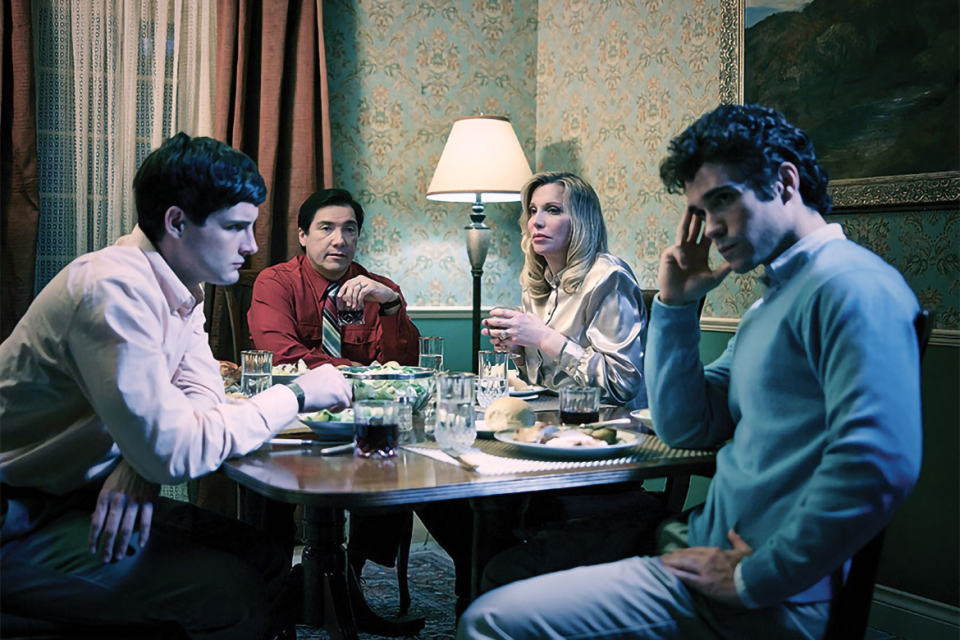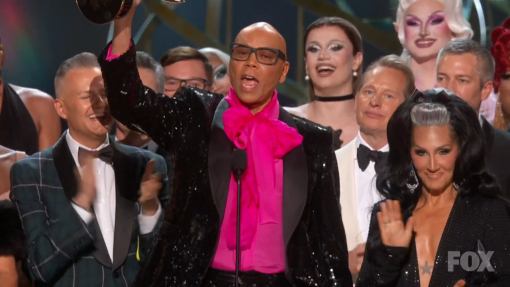Rushing into the conference room on the top floor of the 1930s art deco building they own on Hollywood Boulevard, Randy Barbato and Fenton Bailey apologize for their lateness.
They’ve just come from the edit room, where they locked the final cut of Menendez: Blood Brothers, a TV movie they coproduced and codirected for a June debut on Lifetime.
Blood Brothers is one of hundreds of projects made by World of Wonder, the production company they have jointly operated since 1991. Bailey and Barbato have flourished by crossing genres and media platforms, and by spotlighting extreme and often controversial topics, including tabloid news, gender roles, LGBT issues and, more generally, almost all aspects of human sexuality.
“Sex is the engine or driving force of who humans are,” Bailey says. “We don’t see a shame in talking about such things.” Barbato reinforces the point: “Sex is misunderstood and maligned. The more we can understand sex and sexuality and be open about it, the healthier as a culture we can be. So, I think our obsession with it is really a public service!”
That philosophy illustrates the nature of their unique partnership, and it’s one reason they’ve thrived for so long in an industry that often drives people apart. They work on what interests them — the more unusual, the better.
Those interests led, from the earliest days of their career, to an ongoing collaboration with actor-producer–drag queen RuPaul, which in 1997 spawned The RuPaul Show on VH1 and later, RuPaul’s Drag Race, a reality show on Logo. In 2016, the show earned RuPaul his first Primetime Emmy.
WOW also produces Big Freedia: Queen of Bounce, a documentary series on Fuse about a New Orleans entertainer’s quest for fame; the series returns this year with a new title, Big Freedia Bounces Back.
WOW has produced documentaries on such topics as pornography, masturbation and prostitution; examinations of salacious public figures like Traci Lords, Larry Flynt, John Wayne Bobbitt and Heidi Fleiss; and niche studies on Gay Hollywood (AMC, 2003) and Power Lesbians (BBC, 2005), among many others.
When it comes to the transgendered community, WOW was ahead of the curve, with documentaries like the Sex Change Hospital series (WE tv, 2008), the Chaz Bono telefilm Becoming Chaz (OWN, 2011), Transcendent (a Fuse series, launched in 2015) and most recently, the Gender Revolution series (National Geographic, 2017).
Sheila Nevins, president of HBO Documentary Films, sought out Bailey and Barbato in the early ’90s after seeing an early documentary of theirs called Videos, Vigilantes and Voyeurism on English television. That show explored the camcorder revolution, building on a theme that helped launch Barbato and Bailey’s producing careers.
Fascinated by New York public-access television, the duo created their first TV show, Manhattan Cable, out of public-access clips in 1991. It was a hit in the U.K. and led to more programs there, like the one that eventually earned Nevins’s attention. She hired them in 1993 to produce HBO’s Shock Video doc (and then its sequels) and has been working with them ever since.
Nevins says their fresh approach was what HBO’s documentary unit needed. “HBO wanted to distinguish itself from the mainstream,” she recalls. “They were interested in pushing limits.”
She credits World of Wonder with being a leader in introducing gay culture to television viewers: “Their sensibility is to be joyful, and I think they are part of the cutting edge of the acceptability of homosexuals in the mainstream of our culture. They were really in the forefront of that, because they were out before it was in to be out, and they embraced drag before drag was really drag [culturally speaking]. They introduced gay culture to the media, and they should take full credit for that.”
Even so, sex and gender are hardly the only themes the two men “obsess over,” as Bailey puts it. Much of their work revolves around studying the media’s role in pop culture. They also have “a massive fascination with real estate,” in Barbato’s words, which led them to launch the successful Million Dollar Listing franchise on Bravo. Emotionally, however, Barbato insists most of their work deals with “outsiders like us.”
“We just feel an empathy or connection to people who are maligned or misunderstood,” he explains. “I think our work typically has a connection to people who feel marginalized or judged.”
Bailey calls this the pursuit of “stories about people who are over-exposed but under-revealed.” The Menendez piece — about the Beverly Hills brothers who shotgunned their parents to death in 1989 — is the latest example, but one could also point to their 1994 BBC documentary, O.J. Mania: The Media Trial of O.J. Simpson, and to their award-winning 2000 theatrical documentary, The Eyes of Tammy Faye, a look at the fall of televangelist Jim Bakker.
Party Monster, their 1998 “shockumentary” about famed Manhattan club kid–turned–convicted murderer Michael Alig, is in the same vein. In 2003, Bailey and Barbato adapted a theatrical feature of the same name, and they’re prepping a new documentary on Alig. Party Monster 3 will look at his life now, after a 17-year stretch in prison.
Their storytelling continues to tack closely to today’s cultural zeitgeist. Out of Iraq, their 2016 Logo documentary about two gay Iraqi soldiers, won a Daytime Emmy. Their HBO documentary Mapplethorpe: Look at the Pictures, a project Nevins brought them about controversial gay photographer Robert Mapplethorpe, was nominated for two Primetime Emmys in 2016.
WOW recently partnered with NatGeo to produce Gender Revolution, hosted by Katie Couric. One ripped-from-the- headlines episode profiled the legal quest of transgendered teen Gavin Grimm to use a boys’ bathroom at school, an issue that hurtled toward the Supreme Court as the show was airing.
Nevins adds that HBO and WOW are developing an immigration-themed documentary about the Statue of Liberty, to be executive-produced by Diane von Fürstenberg.
Obviously, there’s a dichotomy in this body of work — deep, highly acclaimed documentaries on serious subjects on the one hand, and smaller, lighter, pop-culture documentaries or reality shows on the other. Barbato and Bailey don’t deny the dichotomy. In fact, they embrace it.
According to Barbato, “We’ve always mixed highbrow and lowbrow.” Bailey adds, “We see things a lot of other people might dismiss as lowbrow culture or ephemeral or even trash as something that is often unexamined or unconsidered. We like to find the depth in the profound.”
NatGeo president Tim Pastore initially worked with WOW on a six-part series called Original Sin: How Sex Changed the World (2016). He was so impressed by HBO’s Mapplethorpe that same year, he decided Barbato and Bailey should produce Gender Revolution, too.
“First, Mapplethorpe is a stunning piece of work, and second, I believe WOW has been a leader in producing LGBTQ awareness and positive programming through their work for decades,” Pastore states. “They are one of the rare companies that can bridge the divide between pop-culture programming and premium documentary.
"And tackling gender appropriately in a documentary is a heavy responsibility that not only requires a passion and scholarship for the topic, but the ability to meld elevated and complex conversations with accessible filmmaking craft and technique.”
Still, what makes WOW unique is not the projects themselves, but the fact that Barbato and Bailey have gotten so many of them made over the years. Indeed, their business approach has been rather conservative. Management has remained stable, many employees have been with them for years (if not decades), they collaborate with the same partners repeatedly, they strategically nurture key relationships and they deliver on time and on budget.
In fact, NatGeo’s Pastore says that when he works with WOW, “I never worry about how the budget is being managed.”
Bailey explains: “We’ve always had to make [the shows] ourselves. To this day, we have not ever had anything greenlit in the room. There are lots of projects we do without any financing or network commitment.”
Barbato adds, “We have showrunners and producer-directors on staff, people who grew up here. It’s hardly a two-man show, and we are filled with gratitude for that.”
This business approach has also freed them creatively. Despite their daily producing duties, the duo routinely direct documentaries and television movies themselves, always as a team. They both enjoy the work, and they like “to get our hands dirty,” as Bailey says. In any case, they say their creative and business work melded long ago in a way that makes it hard for them to distinguish between the two.
“There really isn’t a great deal of difference between the work of making the stories and the work of the production company,” Bailey says. “It’s all part of the process. As a kid, I was fascinated by Andy Warhol and [his studio] the Factory. What was his quote? ‘Being good in business is the most fascinating kind of art.’ He didn’t see that business and art were necessarily different things. We feel that way. It’s all about, how are we going to get things made?”
That’s always been the key question for them. In fact, from their first meeting as graduate film students at NYU, to hanging out at venues like the East Village’s famed Pyramid Club (the heart of NYC’s gay and drag scene in the ’80s), they’ve been enthralled with what Bailey calls “amazing shows with incredible artistry.
"We always felt that artistry and talent should not be for just a small audience. We never thought of that world as taboo. Today we do Drag Race, so the proof is in the pudding.”
They got their show-biz start as a modestly successful disco-pop band called the Fabulous Pop Tarts. But even that work “was all about pop culture as much as about the music,” Barbato says. “That pop-culture obsession has remained with us throughout our careers. We wanted to be filmmakers. The Fabulous Pop Tarts, we hoped, would be a way to make money to fund our films. The band was always designed to help us launch World of Wonder.”
Out of that period came a blaze of relationship-building with several collaborators, most notably RuPaul. Their story goes that one day, about 32 years ago, during a Fabulous Pop Tarts tour stop in Atlanta, they saw RuPaul wheat-pasting posters of himself onto walls. They hit it off and had an “immediate realization,” in Bailey’s words, that RuPaul was going to be a big star.
For his part, RuPaul says he was immediately impressed that they “were already putting out their own records. I had been recording for years, but I was not doing it on my own. They were already ahead of the game, and I admired that. They were producing my album, Star Booty, as far back as 1986, but really started managing me in 1991.”
They’ve collaborated regularly ever since, RuPaul says, because the recognition of talent was mutual at that first meeting. He saw that Barbato and Bailey had the potential to be top-tier producers. He adds that the three of them are cut from the same cloth.
“We’re all the same age,” he says. “We all had this irreverence and the love of thinking outside the box, and loving people who dance to the beat of a different drummer. And we all grew up loving Monty Python on television, and David Bowie and Andy Warhol. We were grooving on the same vibe. We were part of the same tribe.”
RuPaul isn’t the only one who feels that way. TV producer-personality Andy Cohen, another pop-culture enthusiast, met Bailey and Barbato when he booked RuPaul to appear on CBS This Morning in the early ’90s. Cohen says their mutual fascination with RuPaul convinced him they were “kindred spirits who like to make their own rules.”
He eventually hired them to make shows for the short-lived Trio arts and culture network in the ’90s. WOW currently produces one of Cohen’s Bravo shows, Then and Now with Andy Cohen. Meanwhile, Bailey is a presenter of The WOW Report — a pop-culture countdown segment on Cohen’s SiriusXM Radio channel, Radio Andy — with Tom Campbell (chief creative officer) and James St. James (editor of The WOW Report).
“I was attracted to their sensibility and wanted to be in business with them,” Cohen recalls. “I could tell they loved pop culture as much as I did and had this great energy. We did such weird stuff at Trio. I mean, they came up with a brilliant concept about TV shows that were canceled. We did a whole time slot around that conceit.” The Brilliant, but Cancelled documentary premiered in 2002, supported by a programming block; a sequel followed in 2003.
Today, WOW’s reach extends onto multiple platforms. Besides The WOW Report on satellite radio, there’s an active WOW-Presents YouTube channel, a huge social-media presence and a website that offers pop-culture news and entertainment. On the first floor of WOW’s Hollywood headquarters, the “Storefront Gallery” hosts shows and events, including an art show this year called “Surviving Trump: The Art of Resistance.”
In late April, WOW produced RuPaul’s DragCon 2017 at the Los Angeles Convention Center — the world’s first trade show for the drag community and fans of RuPaul and Drag Race. According to RuPaul, the event — now in its third year —is designed to promote the notion that “people should be able to live their life without confining their creativity to a particular box.”
Barbato and Bailey have certainly been doing that for decades. Their creative and business partnership is so strong that, several years ago, it won out over their longtime romantic relationship. As the pressures of being both a couple and business partners mounted, they decided World of Wonder was what they did best together, so they ended their personal involvement.
“We have separate homes, partners and children — we don’t coproduce any of that,” Barbato says. “But our creative projects, we coproduce everything, and it works well.”
Indeed. Ten days after their emmy interview, Barbato and Bailey find themselves in their temporary DragCon production offices at the L.A. Convention Center, gazing through a giant window at the crowded, colorful show floor. They’re giddy at how crowded the show is, even an hour before closing time. By the end of the weekend, attendance will exceed 40,000. “Amazing!” Bailey exclaims.
Such enthusiasm makes it clear why their company is named World of Wonder. “We really believe that,” Bailey says. “We are trying to put a sense of wonder into everything we make, a sense of something that is inspiring in some way — or at least to open up your mind to a new idea or a new thought.”
This article originally appeared in emmy magazine, Issue No. 6, 2017








